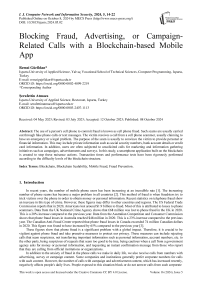Blocking Fraud, Advertising, or Campaign-Related Calls with a Blockchain-based Mobile App
Автор: Remzi Gürfidan, Şerafettin Atmaca
Журнал: International Journal of Computer Network and Information Security @ijcnis
Статья в выпуске: 5 vol.16, 2024 года.
Бесплатный доступ
The use of a person's cell phone to commit fraud is known as cell phone fraud. Such scams are usually carried out through fake phone calls or text messages. The victim receives a call from a cell phone scammer, usually claiming to have an emergency or a legal problem. The purpose of the scam is usually to convince the victim to provide personal or financial information. This may include private information such as social security numbers, bank account details or credit card information. In addition, users are often subjected to unsolicited calls for marketing and information gathering initiatives such as campaigns, advertisements and surveys. In this study, a smartphone application built on the blockchain is created to stop these nuisance actions. Transaction times and performance tests have been rigorously performed according to the difficulty levels of the blockchain structure.
Blockchain, Blockchain Scalability, Mobile Fraud, Fraud Prevention
Короткий адрес: https://sciup.org/15019470
IDR: 15019470 | DOI: 10.5815/ijcnis.2024.05.02
Список литературы Blocking Fraud, Advertising, or Campaign-Related Calls with a Blockchain-based Mobile App
- H. Zhu, H. Xiong, Y. Ge, and E. Chen, “Discovery of ranking fraud for mobile apps,” IEEE Trans Knowl Data Eng, vol. 27, no. 1, pp. 74–87, Jan. 2015, doi: 10.1109/TKDE.2014.2320733.
- M. Yelland, “Fraud in mobile networks,” Computer Fraud & Security, vol. 2013, no. 3, pp. 5–9, Mar. 2013, doi: 10.1016/S1361-3723(13)70027-7.
- “Canada News Today | CTV News.” https://www.ctvnews.ca/canada/saad-salman-1.5260052 (accessed Apr. 28, 2023).
- W. Wang et al., “A Survey on Consensus Mechanisms and Mining Strategy Management in Blockchain Networks,” IEEE Access, vol. 7, pp. 22328–22370, 2019, doi: 10.1109/ACCESS.2019.2896108.
- A. Kamišalić, R. Kramberger, and I. Fister, “Synergy of Blockchain Technology and Data Mining Techniques for Anomaly Detection,” Applied Sciences 2021, Vol. 11, Page 7987, vol. 11, no. 17, p. 7987, Aug. 2021, doi: 10.3390/APP11177987.
- X. Zhang, R. Qin, Y. Yuan, and F. Y. Wang, “An Analysis of Blockchain-based Bitcoin Mining Difficulty: Techniques and Principles,” Proceedings 2018 Chinese Automation Congress, CAC 2018, pp. 1184–1189, Jan. 2019, doi: 10.1109/CAC.2018.8623140.
- D. Kraft, “Difficulty control for blockchain-based consensus systems,” Peer Peer Netw Appl, vol. 9, no. 2, pp. 397–413, Mar. 2016, doi: 10.1007/S12083-015-0347-X/TABLES/3.
- Y. Lin et al., “Dynamic Control of Fraud Information Spreading in Mobile Social Networks,” IEEE Trans Syst Man Cybern Syst, vol. 51, no. 6, pp. 3725–3738, Jun. 2021, doi: 10.1109/TSMC.2019.2930908.
- C. M. R. Haider, A. Iqbal, A. H. Rahman, and M. S. Rahman, “An ensemble learning based approach for impression fraud detection in mobile advertising,” Journal of Network and Computer Applications, vol. 112, pp. 126–141, Jun. 2018, doi: 10.1016/J.JNCA.2018.02.021.
- H. Grosser, P. Britos, and R. García-Martínez, “Detecting fraud in mobile telephony using neural networks,” Lecture Notes in Computer Science (including subseries Lecture Notes in Artificial Intelligence and Lecture Notes in Bioinformatics), vol. 3533 LNAI, pp. 613–615, 2005, doi: 10.1007/11504894_85/COVER.
- R. Mouawi, M. Awad, A. Chehab, I. H. El Hajj, and A. Kayssi, “Towards a Machine Learning Approach for Detecting Click Fraud in Mobile Advertizing,” Proceedings of the 2018 13th International Conference on Innovations in Information Technology, IIT 2018, pp. 88–92, Jan. 2019, doi: 10.1109/INNOVATIONS.2018.8605973.
- P. O. Goffard, “Fraud risk assessment within blockchain transactions,” Adv Appl Probab, vol. 51, no. 2, pp. 443–467, Jun. 2019, doi: 10.1017/APR.2019.18.
- P. Joshi, S. Kumar, D. Kumar, and A. K. Singh, “A Blockchain Based Framework for Fraud Detection,” 2nd International Conference on Next Generation Computing Applications 2019, NextComp 2019 - Proceedings, Sep. 2019, doi: 10.1109/NEXTCOMP.2019.8883647.
- S. Zou, J. Xi, H. Wang, and G. Xu, “CrowdBLPS: A Blockchain-Based Location-Privacy-Preserving Mobile Crowdsensing System,” IEEE Trans Industr Inform, vol. 16, no. 6, pp. 4206–4218, Jun. 2020, doi: 10.1109/TII.2019.2957791.
- D. Liu and J. H. Lee, “CFLedger: Preventing chargeback fraud with blockchain,” ICT Express, vol. 8, no. 3, pp. 352–356, Sep. 2022, doi: 10.1016/J.ICTE.2021.06.001.
- G. Saldamli, V. Reddy, K. S. Bojja, M. K. Gururaja, Y. Doddaveerappa, and L. Tawalbeh, “Health Care Insurance Fraud Detection Using Blockchain,” 2020 7th International Conference on Software Defined Systems, SDS 2020, pp. 145–152, Apr. 2020, doi: 10.1109/SDS49854.2020.9143900.
- G. Zhang, X. Zhang, M. Bilal, W. Dou, X. Xu, and J. J. P. C. Rodrigues, “Identifying fraud in medical insurance based on blockchain and deep learning,” Future Generation Computer Systems, vol. 130, pp. 140–154, May 2022, doi: 10.1016/J.FUTURE.2021.12.006.
- M. Kara et al., “A Compute and Wait in PoW (CW-PoW) Consensus Algorithm for Preserving Energy Consumption,” Applied Sciences 2021, Vol. 11, Page 6750, vol. 11, no. 15, p. 6750, Jul. 2021, doi: 10.3390/APP11156750.
- A. Gervais, G. O. Karame, K. Wüst, V. Glykantzis, H. Ritzdorf, and S. Čapkun, “On the security and performance of Proof of Work blockchains,” Proceedings of the ACM Conference on Computer and Communications Security, vol. 24-28-October-2016, pp. 3–16, Oct. 2016, doi: 10.1145/2976749.2978341.
- W. Ren, J. Hu, T. Zhu, Y. Ren, and K. K. R. Choo, “A flexible method to defend against computationally resourceful miners in blockchain proof of work,” Inf Sci (N Y), vol. 507, pp. 161–171, Jan. 2020, doi: 10.1016/J.INS.2019.08.031.
- H. Hellani, L. Sliman, A. E. Samhat, and E. Exposito, “On Blockchain Integration with Supply Chain: Overview on Data Transparency,” Logistics 2021, Vol. 5, Page 46, vol. 5, no. 3, p. 46, Jul. 2021, doi: 10.3390/LOGISTICS5030046.
- R. A. Groeneveld and G. Meeden, “Measuring Skewness and Kurtosis,” Journal of the Royal Statistical Society: Series D (The Statistician), vol. 33, no. 4, pp. 391–399, Dec. 1984, doi: 10.2307/2987742.
- D. N. Joanes and C. A. Gill, “Comparing measures of sample skewness and kurtosis,” Journal of the Royal Statistical Society: Series D (The Statistician), vol. 47, no. 1, pp. 183–189, Apr. 1998, doi: 10.1111/1467-9884.00122.


